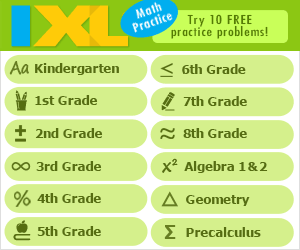8th Grade English Language Arts - Research Standards
To work on eighth grade research standards, click on the numbers below to visit pages of internet resources for each of the learning standards.
Checks for Understanding are at the top of this page. Scroll down to find internet resources related to the State Performance Indicators (SPIs).
Checks for Understanding (Formative/Summative Assessment)
0801.4.1 Narrow a Topic - Narrow a topic so that the research process is manageable and the controlling idea is focused. 0801.4.2 Take Notes - Take and organize notes on what is known and what needs to be researched about the topic. 0801.4.3 Relevance - Focus on information and/or relevant theories. 0801.4.4 Primary and Secondary - Distinguish between primary and secondary sources, defining the characteristics of each and evaluating each for their benefits and limitations. 0801.4.5 Reliability of Source - Choose among sources provided and those found independently based on the usefulness, credibility, and reliability of the sources. 0801.4.6 Selecting Sources - Identify reasons for choosing one source over another, including those found on Web sites. 0801.4.7 Source Limitations - Identify the characteristics and limitations of source material. 0801.4.8 Develop Topic - Provide relevant research information to develop and support a complicated topic. 0801.4.9 Interpret Data - Analyze and interpret data in multiple forms (e.g., a bar or circle graph) on a familiar topic. 0801.4.10 Collect Evidence - Collect evidence in various ways (e.g., gathering relevant reasons, examples, and facts; defining key terms and ideas; identifying relationships such as cause-effect). 0801.4.11 Introduction - Craft an introductory paragraph in which a thesis statement(s) clearly presents the topic of the documented essay. 0801.4.12 Pertinent Facts - Present a body of well-developed and specific facts and information pertinent to the topic, developed as a series of paragraphs which support the topic. 0801.4.13 Transition - Connect more complicated ideas using a variety of transition strategies. 0801.4.14 Organizing Structure - Create an effective organizing structure based on more complicated research information (e.g., description, problem-solution, question-answer, compare-contrast, cause-effect). 0801.4.15 Conclusion - Craft a conclusion in which closure is provided, such as by restating the topic and summarizing findings. 0801.4.16 Source - Acknowledge source material using a predetermined standard format (e.g., APA, MLA). 0801.4.17 Paraphrasing or Summarizing - Understand the differences among quoting, paraphrasing, and summarizing. 0801.4.18 Paraphrase - Quote, paraphrase, or summarize text, ideas, or other information taken from print or electronic sources. 0801.4.19 Graphics - Embed graphics with good accuracy and some skill, when appropriate. 0801.4.20 Format - Following a standard format and appropriate technology, embed text graphics, including a title, a contents page, numbered pages, and a bibliography. 0801.4.21 Include Graphics - Include graphics and illustrative material effectively to support research ideas in the text. State Performance Indicators
SPI 0801.4.1 Topic - Select the most focused research topic. SPI 0801.4.2 Reliability - Identify levels of reliability among resources (e.g., eyewitness account, newspaper account, supermarket tabloid account, Internet source). SPI 0801.4.3 Appropriate Source - Determine the most appropriate research source for a given research topic. SPI 0801.4.4 Primary or Secondary - Distinguish between primary (i.e., interviews, letters, diaries, newspapers, autobiographies, personal narratives) and secondary (i.e., reference books, periodicals, Internet, biographies, informational texts). SPI 0801.4.5 Relevancy - Discern irrelevant research material from written text. Review Help Resources to help review Eighth Grade English Language Arts standards
Search Internet4Classrooms

Custom Search






